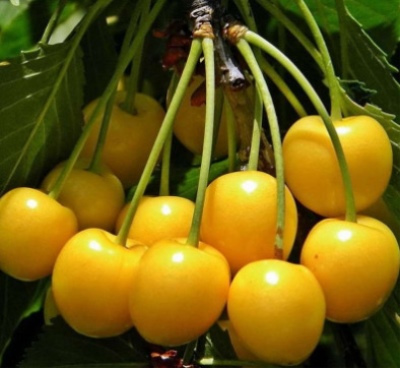
- Fruit shape: heart-shaped
- Growth type: vigorous
- Appointment: universal
- Tree height, m: 4
- Crown: pyramidal, spreading, raised, medium density
- Escapes: medium, straight, yellowish, naked
- Sheet: oval, green
- Fruit size: medium-sized
- Fruit weight, g: 3,6
- Fruit color: yellow
The cherry variety Orlovskaya Amber differs from the traditional representatives of this family in color - the berry is colored in yellow tones, acquiring an amber palette and translucency at the time of physiological ripeness. Yellow fruits are intended for fresh consumption, from which delicious and beautiful compotes, preserves, jams and confitures are cooked. In addition, berries provide a preventive effect for many diseases, have a positive effect on blood composition and the work of the gastrointestinal tract.
Description of the variety
A vigorous (from 4 m) tree with a pyramidal spreading crown looks very attractive during flowering or fruit ripening. In the first case, it is covered with snow-white boil, from under which the foliage is almost invisible, in the second - glowing amber berries against the background of emerald foliage create a stunning effect.
A raised crown of medium density is created by naked straight shoots of yellowish shades and slightly drooping branches covered with a grayish skin. An oval leaf blade of rich green color with a smooth surface has double-serrate edges and a long pointed tip. Fruits are tied on fruit twigs and bouquet twigs.
Fruit characteristics
Heart-shaped and not too large (3.6 g) fruits are colored yellow, gaining intensity as they ripen. A small (0.2 g) stone separates well from the pulp, the berry is resistant to cracking and is characterized by a medium separation.
Taste qualities
Medium-dense, very juicy yellow pulp has a sweet, balanced taste and colorless juice. The fruits contain dry soluble substances (14%), sugar (10.4%), acids (0.4%). Berry tasting score - 4.4 points.
Ripening and fruiting
The variety belongs to the mid-late category, fruiting occurs in the third year after planting. The approximate flowering occurs in mid-May, the harvest is harvested in mid-July.

Yield
Amber cherry is distinguished by its ability to give high yields. On average, from 75 centners are harvested from one hectare, the maximum value is 120 centners / ha.
Self-fertility and the need for pollinators
It is vitally important for self-fruitless cherries to find pollinating varieties nearby, without which they will not be able to produce a crop. Such varieties are Vityaz, Iput, Gostinets, Severnaya and Ovstuzhenka.
Growing and care
For the cultivation of Orlovskaya Amber, places with good lighting and protection from northern winds are chosen. The culture develops well and bears fruit on fertile, drained soils with a neutral level of acidity. Neighborhood with ground waters closer than 2.5 meters from the earth's surface is unacceptable.Also, cherries do not survive in swampy lowlands, therefore, if a suitable site has exactly such parameters, then it is necessary to create an artificial mound on which the plant should be planted.
If the earth is acidic, then it is imperative to add dolomite flour, chalk, lime or gypsum. Wood ash lowers acidity well. The optimal size of the planting pit is 60x60x80 cm. At the bottom, a drainage layer of gravel, pebbles, fine gravel or broken brick is arranged. Simultaneously with the drainage device, a support for the seedling is installed. The removed fertile layer is enriched with organic matter (humus, compost, bird droppings), superphosphate, complex specialized mineral fertilizers, and wood ash.
After planting, a barrier embankment is arranged around the trunk circle and watered abundantly with warm water. The next day, the moist soil must be loosened to prevent the formation of a dense crust that impedes the penetration of oxygen. Loosening perfectly replaces the mulching method - a thick layer of mulch prevents moisture evaporation, inhibits weeds, and prevents the formation of an earthen crust.
Further care consists in moderate watering, obligatory weeding, top dressing, sanitary and formative pruning. The plant in the first year of life especially needs care, therefore watering is carried out weekly during the dry period, an adult tree is watered no more than once a month.
They begin to feed cherries from the second year after planting. In the spring, nitrogen fertilizers are applied, in the summer - potassium-phosphorus fertilizers, in the fall, the trunk circles are covered with a thick layer of humus. To combat rodents, the trunks and part of the lower skeletal branches are whitewashed with a solution of lime mixed with copper sulfate. For the winter, it is advisable to wrap the trunks with special nets, deepening them into the soil. In order to avoid freezing of the root system, the near-trunk zone is covered with a thick layer of snow in winter.




Disease and pest resistance
The variety has good resistance to moniliosis and coccomycosis.

Requirements for soil and climatic conditions
The tree has a high potential for tolerance to negative temperatures - generative buds are able to withstand frosts down to -20ºC. With regard to drought resistance, it has average values.
































































